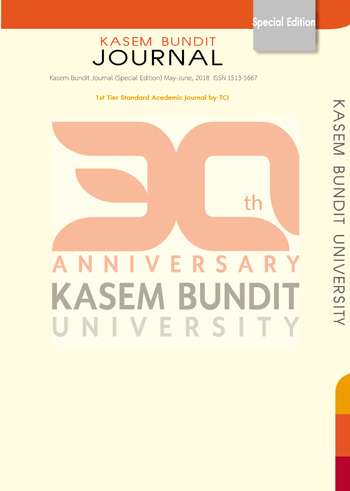Happy Workplace: A Case Study of Kasem Bundit University Employees
Keywords:
Happiness, Happy Workplace, Organization DevelopmentAbstract
This study used qualitative research to study the definition, factors of a happy workplace and the results of a happy workplace of Kasem Bundit University employees with the following objectives: 1) to describe the definition of a happy workplace 2) to study the factors that create a happy workplace and 3) to study the happy workplace which affects employees’ work using in-depth interviews and literature reviews. The sample size (key informant) of this research consisted 12 employees. The results revealed that 1) the definition of a happy workplace was the organization that encouraged its employees to have a common goal, focus on adjusting a new work process, have operation guidelines which supported one another, strive for highest efficiency; moreover, the employees themselves had a chance to do what they loved, had a good attitude towards work, had good colleagues, were happy to work and loved their work 2) the overall factors that created a happy workplace included a total of 9 elements in accordance with the concept of a happy workplace of Thai Health Promotion Foundation (Thai-Health), which consisted of 7 elements as follows: Happy Body, Happy Heart, Happy Relax, Happy Brain, Happy Soul, Happy Family and Happy Society. In addition, the researchers found additional 2 elements i.e. Happy Instrument and Happy Environment 3) The happy workplace which affected employees’ work could be divided into three types: the happy workplace affecting employees themselves, affecting colleagues and affecting the organization. It could be described that 3.1) the happy workplace affecting themselves (the employees), namely making them happy, enthusiastic to work, willing to work, and ready to develop themselves 3.2) affecting colleagues, namely creating collaboration, unity, helping one another and working together happily and 3.3) affecting the organization, namely improving performance, building loyalty in the organization and organization development.
References
[2] Business Thai. (2008). “Global Survey shows Thai Businesses not enough to take care of recruitment and incentives”. [Serial Online]. 2008 [cited July 18, 2017]. Available from: URL: https://positioningmag.com/40285
[3] Creswell, J. W. (1998). Qualitative inquiry and research design: Choosing among five traditions. Thousand Oaks, CA: Sage Publications.
[4] Cynthia D. Fisher. (2010). “Happiness at work”. International Journal of Management Reviews. Vol.12 (No.4): Pages 384-412.
[5] Glaser, B. G. & Strauss, A. L. (1967). The discovery of grounded theory: Strategies for qualitative research. Piscataway, New Jersey: Transaction.
[6] Jose Luis Fernandez Fernandez, Manuel Angel Fernandez Gamez, Nuria
De Querol Aragon, and Angela Callejon Gil. (2017). Happiness at work,
Business behaviour, and Worker perceptions: A case study. Ramon Llull
Journal of Applied Ethics. Vol.8: Pages 33-64.
[7] Kitipat Nontapattamadoon. (2011). “Research Zone (2011): Phase 51”. Qualitative Research in Social Welfare: Concepts and Research Methods. Bangkok: Thammasat University Press: Pages 119-157.
[8] Morse, J. M. (1994). Designing funded qualitative research. In Denizin, N. K. & Lincoln, Y. S., Handbook of qualitative research (2nd Ed). Thousand Oaks, CA: Sage.
[9] Narumon Sawaengpol. (2011). “Factor Affecting Happiness in Personnel Working at Faculty of Business Administration, Rajamangla University of Technology Thanyaburi (RMUTT)”. General Management. Faculty of Business Administration. Rajamangla University of Technology Thanyaburi.
[10] Phajon Chalermsarn. (1997). “The Quality of Working Life Middle Workers: A Case of Wellgrow Industrial Estate, Chachoengsao Province”. Master of Arts (Social Development). Social Development Management. National Institute of Development Administration.
[11] Phathara-on Wesarat, Mohmad Yazam Sharif & Abdul Halim Abdul Majid. (2015). “A Conceptual Framework of Happiness at the Workplace”. Asian Social Science. Vol. 11. (No. 2): Pages 78-88.
[12] Porntipa Somboonlertsiri and Jiraporn Rahothan. (2013). “Happy Workplace Model and Quality of Work Life Effect to Organization Effectiveness of IRPC Public Company Limited”. Journal of Behavioral Science for Development. Vol.5 (No.1). January 2013. ISSN 2228-9453: Pages 19-31.
[13] Prapon Pasukyued. (2006). “Knowledge Management”. Bankok: Yaimai.
[14] Sasithorn Laoteng & Viroj Jadesadaluk. (2014). “The Influence of Happiness Activities in the Organization by Happy-8 Model toward Happiness at Work, Productivity of Work and Intention to Resign of Workers in a Private Company”. Veridian E-Journal. Vol.7 (No.2): Pages 998-1006.
[15] Salvatore Moccia. (2016). HAPPINESS AT WORK. Psychologist Papers. Vol. 37 (No.2): Pages 143-151.
[16] Sirintip. (2012). “Happy Workplace You are able to build”. [Serial Online]. 2012 [cited June 21, 2017]. Available from: URL: http://www.thaihealth.or.th/
partnership/Content/8058.
[17] Tammattitta Yoocharoen. (2014). “The Linear Structural Equation Model of Creativity, Perceived Organizational Support, The Buddhist Leadership and Happy at Work Affecting Positive Organizational Behavior”. Industrial and Organizational Psychology. King Mongkut’s University of Technology North Bangkok.
[18] Thai Health Promotion Foundation. (2010). “Happy Workplace”. [Serial Online]. 2010 [cited February 12, 2017]. Available from: URL: http://www.happy8workplace.com/.
[19] Thanyarat Kerdsuwan. (2012). “Population Structure and Thai Labor Market”. National Statistical Office. Bangkok: ISBN 978-974-11-3105-1.
[20] Webometrics. (2014). TOP 10 PRIVATE UNIVERSITIES IN THAILAND. [Serial
Online]. 2014 [cited February 12, 2017]. Availablefrom: URL: https://
www. thaiquote.org/content/17120.
[21] Weeraya Sirijanyapong. (2013). “Happiness in work of registered nurses in inpatient department, Ramathibodi Hospital”. M.Sc. (Public Health) Program in Health Administration. Mahidol University.
[22] Yen-Fan Lee. (2014). The Subtle at Work Happiness: A Survey of Nurses'
Favourite Incentive Programs. Tzu Chi Nursing Journal. Vol.8 (June 2014):
Pages 18-27.
Downloads
Published
How to Cite
Issue
Section
License
ทัศนคติ ความคิดเห็นใด ๆ ที่ปรากฏในวารสารเกษมบัณฑิตฉบับนี้เป็นของผู้เขียน โดยเฉพาะ มหาวิทยาลัยเกษมบัณฑิตและบรรณาธิการ ไม่จำเป็นต้องมีความเห็นพ้องด้วย







